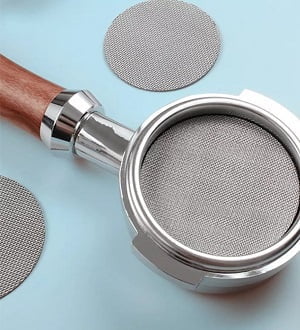One critical aspect of espresso brewing that can make or break the final shot is channeling.
Espresso channeling is a common problem that occurs when the water flowing through the coffee grounds finds a path of least resistance and creates channels, resulting in an uneven extraction and an imperfect shot.
But fear not, with a little knowledge and practice, you can easily prevent channeling and achieve a perfectly balanced espresso shot every time.
This article will help you explore what espresso channeling is, its causes, and how it affects the extraction process.
I will also provide you with tips to prevent channeling, so you can fine-tune your espresso brewing skills and impress your friends and family with your barista-worthy shots.
First, How to Know if espresso is Channeling?
First of all, Inspect the Puck to find out whether the Espresso is channeling or not!
One of the clear signs of espresso channeling is the appearance of uneven channels or holes in the coffee puck after extraction. These channels may be visible on the top of the puck or at the sides of the portafilter basket.



The ideal Espresso puck should have a consistent shape and size, with no visible indentations or cracks. The coffee puck should be dry (Ideally!), indicating that the espresso machine has extracted all the available water from the coffee grounds.
A firm puck indicates that the coffee was tamped properly and evenly, which is crucial for even extraction.

The second way to detect Channeling is to Observe the extraction.
If you use a Naked or Bottomless portafilter then you can very easily identify the channeling.
Channeling is evident if you observe these signs.
- The Espresso is pouring from one side of the Portafilter – This happens because of side tamping
- The Flow of Espresso isn’t exactly from the center.
- There is more than one stream of coffee – This happens because of empty air pockets and low-density spots inside the puck
- Espresso is only pouring from the edges of the basket – This happens when the size of the tamper is smaller than the basket or while using convex tampers.
- Spitting and Sputtering of coffee is also a sign of Channeling.
This is how coffee channeling looks like visually:



The ideal espresso stream should be thick, smooth, and have a consistent flow rate. A thick and smooth stream indicates proper grinding and tamping, while a consistent flow rate ensures even extraction.

If you suspect that your espresso is channeling, it’s essential to take action to prevent it from happening again. By paying attention to the signs of channeling and adjusting your brewing technique accordingly, you can ensure a consistent and delicious espresso shot every time.
Look for the following signs if you can’t visualize channeling with a bottomless filter:
- Rapid extraction: If your espresso shot pours too quickly, it may be a sign of channeling. The ideal extraction time is around 25-30 seconds.
- Uneven color: Check the color of your espresso shot. If it has uneven and patchy colors, it could be a sign of channeling.
- Thin crema: Espresso shots with thin or no crema can also be a sign of channeling.
- Weak or Uneven Taste: A weak or bitter espresso shot is usually the result of uneven extraction caused by espresso channeling.
Read a detailed guide on types of Espresso Portafilters and why Naked portafilters are better.
What causes channeling in Espresso?
There are two causes of Espresso Channeling using too fine or inconsistent grind size and not distributing or tamping the coffee grounds properly in the portafilter.
1- Using Wrong Grind Size: When your grind size is inconsistent and has a lot of fine powder along with bigger chunky grounds, the fine stuff gets super compacted leaving spaces for channels. Same deal if the grind is just way too fine overall – it can create a dense cake that prevents water from evenly extracting the coffee. The pressurized water will find a way to pass through the less dense areas of the coffee, which can lead to uneven extraction and channeling.
2- Not distributing the Grounds Properly: Channeling can also happen if you don’t properly distribute the coffee grounds in the portafilter. If the grounds aren’t evenly distributed, you’ll end up with empty air pockets in the puck. The water will naturally take the path of least resistance, causing channels to form. That’s why Proper Tamping is very important as it helps to distribute the coffee grounds in the portafilter evenly.
How does Espresso Channeling Affect Extraction and taste?
Espresso channeling can have a terrible impact on the extraction and the taste of your shot.
When the channeling occurs, the water ends up taking a straight route through the path of least resistance instead of evenly absorbing into the whole puck. This leads to serious under-extraction in the areas missed by the water. On the flip side, the grounds in the channel areas get super over-extracted by that concentrated water flow.
So you end up with a mix of sour, undeveloped flavors from the under-extracted zones and harsh, bitter notes from the over-extracted channels.
The final shot will be thin and watery with an unbalanced mix of bitter and sour notes instead of that full-bodied, multi-layered espresso with a thick layer of crema.
How to Prevent or Stop Channelling in Espresso
Here are my five exclusive tips to Fix Channeling Espresso.
Tip # 1: Grind the coffee beans perfectly
The grind size of the coffee beans is very important in espresso brewing. A perfect grind size ensures that the water flows evenly through the coffee, preventing channeling.
To find the perfect grind size for your espresso machine and coffee beans, it is recommended to start with a medium-fine grind and adjust from there toward the finer settings.
If your shots are extracting too quickly, it means the water is flowing too easily through the coffee, try using a finer grind size. Conversely, if your shots are extracting too slowly, it means the water is having difficulty flowing through the coffee, try using a coarser grind size.
It’s important to note that the grind size can vary depending on the type of coffee beans used.
When grinding your coffee beans, it’s essential to consider the type of grinder you use. Burr grinders are the preferred choice for espresso brewing, as they produce a consistent and uniform grind size. Never use blade Grinders!
Properly Dialing in the Espresso Machine is the Key here. Read a guide on how to dial in Espresso Machine
Tip # 2: Never add coffee grounds to wet portafilter
Adding coffee grounds to a wet portafilter can lead to clumping which will eventually lead to chanelling. To avoid this, always make sure the portafilter is completely dry before adding the coffee grounds.
A simple step of wiping down the portafilter with a dry towel or cloth can prevent channeling and ensure a perfectly balanced shot.
Tip # 3: Distribute the coffee grounds properly
It is necessary to distribute the coffee grounds properly in the portafilter. Uneven distribution can lead to channels forming in the coffee puck.
A distribution tool can help to level the coffee grounds in the portafilter.
Alternatively, you can use your finger to distribute the coffee grounds manually. Fill the portafilter with coffee grounds, tap it gently on a hard surface to settle the grounds, and then use your finger to distribute the coffee grounds evenly in the portafilter.


It isn’t necessary to invest in fancy distribution tools if you aren’t an idealist. You can do fine with just a tamper.
Tip # 4: Tamp the coffee grounds perfectly
Proper tamping is necessary in espresso brewing to ensure the even distribution of coffee grounds in the portafilter.
Fill the portafilter basket with coffee and spread the grounds evenly with a distribution tool or you can do it with your finger simply.
Apply firm and even pressure to the grounds with a tamper. The goal is to achieve a flat and level surface that is free of air pockets and gaps.
Many people overthink the tamping pressure. Just tamp with sufficient force until it pushes back at you and you are done.

Tip # 5: Use the Puck Screen to prevent Channeling
A puck screen is a small, perforated disk that sits between the coffee grounds and the portafilter. It can help to prevent channeling by creating a more even surface for the water to flow through.
If you’ve tried all the best practices for preventing espresso channeling and you’re still frustrated, a puck screen might be helpful.
The puck screen has tiny holes that allow water to flow through evenly while extracting espresso.
The puck screen prevents channeling by distributing the water evenly throughout the puck, and results in a more balanced and flavorful espresso shot.

It’s very important to buy a puck screen that exactly matches the size of your portafilter basket otherwise, it will worsen the problem
Final thoughts
I believe that with practice and attention to detail, anyone can avoid espresso channeling and make a perfect espresso shot every time.
When I make espresso, I usually use dark roasted coffee beans and grind them to fine grind settings (around 0.3mm) to ensure a strong and flavorful shot. I also make sure to distribute the coffee grounds evenly in the portafilter before tamping, using a distribution tool to ensure consistency.
I hope this detailed breakdown on “espresso channeling” gave you some handy troubleshooting ideas. Have you conquered channeling woes before? What tricks have you picked up along the way? Share your tips below to help out other home baristas battling the dreaded channel problem!
Check out: Why is Espresso too foamy
FAQs
Why is there no crema in my espresso?
There could be several reasons why there is no crema in your espresso. One possibility is that the coffee beans are not fresh. Stale coffee beans can result in a lack of crema. Another reason could be that the coffee grind size is too coarse, leading to under-extraction and a lack of crema.
Why is my espresso bitter?
A bitter espresso shot can be caused by several factors, such as over-extraction, using too much coffee, or stale coffee beans. Using too fine coffee grounds is the most prominent cause of over-extraction.
Do old beans cause channeling?
Yes, old stale beans can definitely cause channeling. As beans lose freshness over time, they get dried out and end up providing less resistance to pressurized water. This makes it easier for the water to find pathways around the puck rather than penetrating it evenly.




Channeling was always a struggle for me until I started using a distribution tool. Game changer!
Yes, distribution tool is a handy little tool that work wonders!
Has anyone tried the bottom filter screen trick? I Heard it helps prevent channeling on some machines.
Oh yeah, that bottom filter screen thing is legit! Definitely helps with channeling issues. Give it a shot